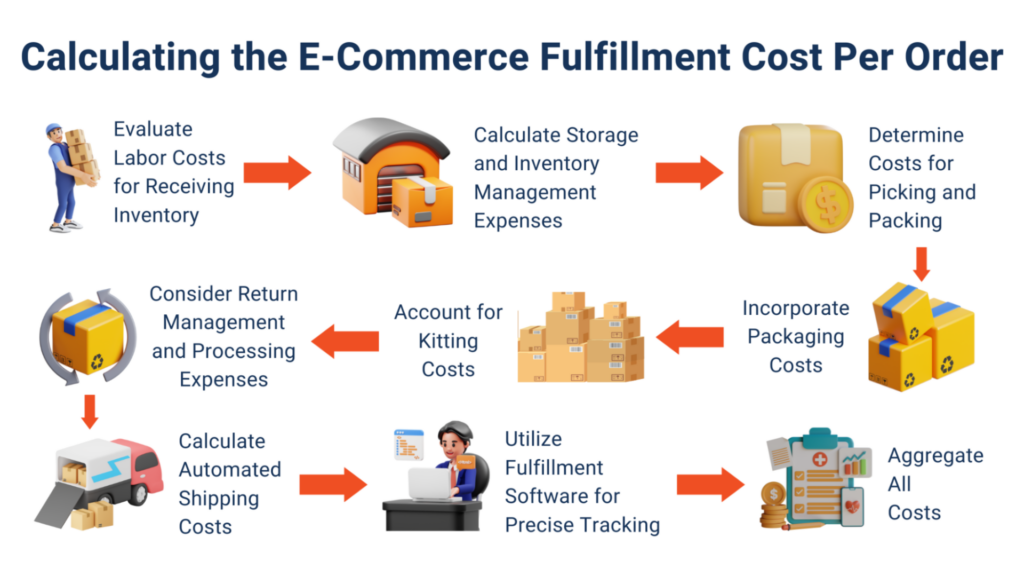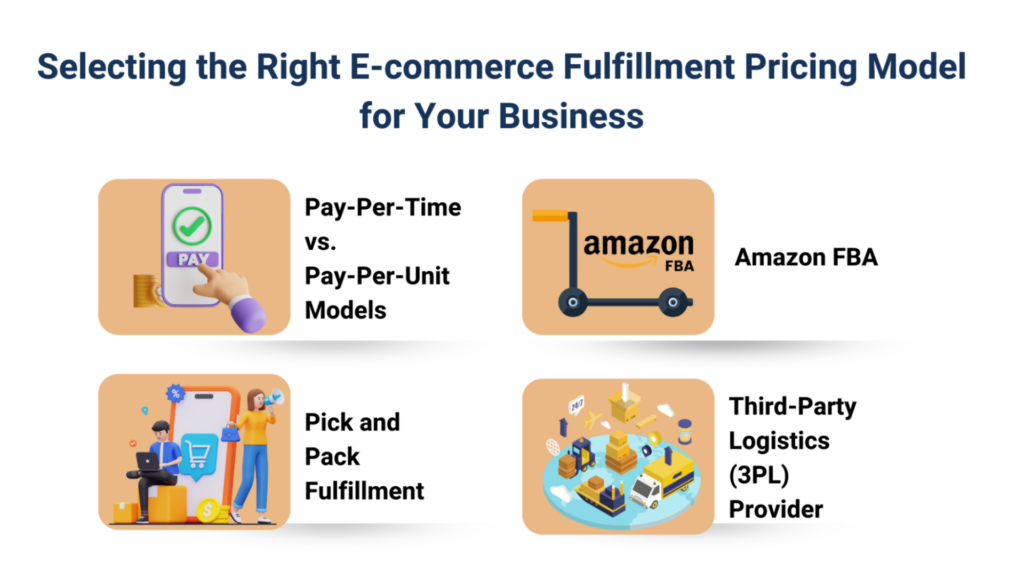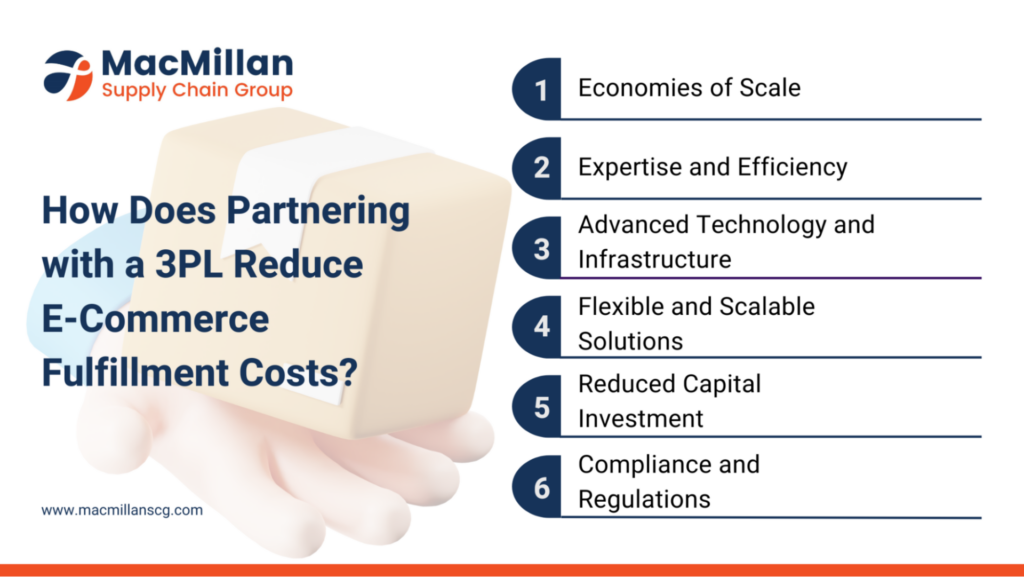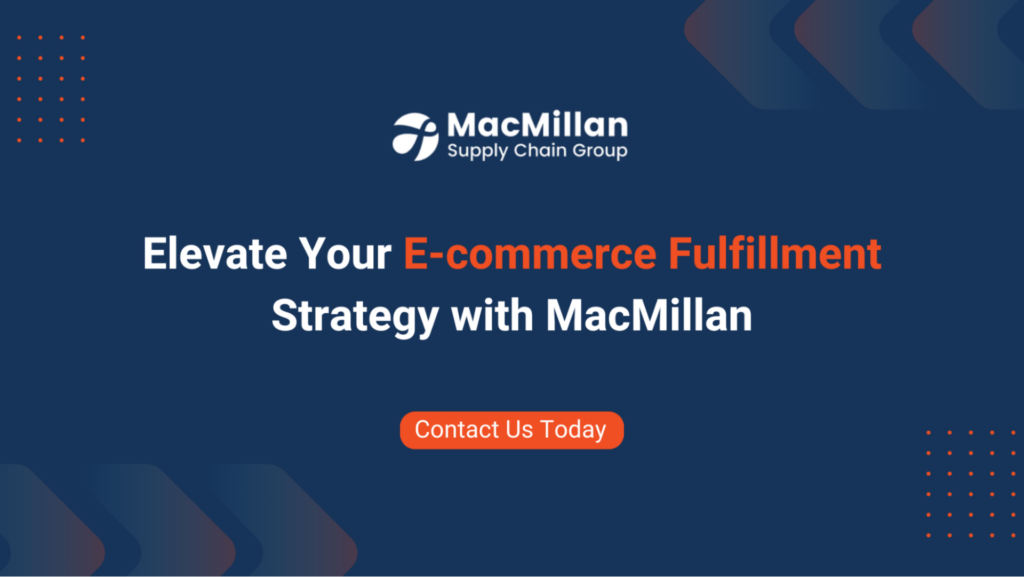Are you aware that nearly half of online shoppers expect same-day delivery, and a delay of just two days can deter 69% of them from returning to your store?
It’s quite fascinating how online shopping is evolving, isn’t it? The expectation for same-day delivery is becoming a norm, and a delay of just two days can deter 69% of them from returning to your store. This reflects the importance of efficient order fulfillment in the e-commerce world.
When we talk about e-commerce, it’s not just about selling products online; getting the product to the customer’s doorstep is equally crucial. With e-commerce sales skyrocketing, the way businesses manage their order fulfillment can really make a difference in their success.
Diving into e-commerce fulfillment costs is quite an interesting journey. So many elements contribute to these costs – from warehousing and inventory management to packing and shipping. Each of these factors adds to the expense and plays a role in how quickly and efficiently you can deliver products to your customers.
Calculating and managing e-commerce fulfillment costs can be challenging, but it’s essential for maintaining a profitable e-commerce business. It’s all about finding that sweet spot where you can deliver quickly and efficiently without breaking the bank.
Let’s delve deeper into this and explore the various aspects of e-commerce fulfillment costs. We’ll look at how these expenses are calculated and what factors can influence them. It’s a crucial part of the puzzle for any online retailer looking to thrive in today’s market.
A Comprehensive Overview of E-commerce Fulfillment Costs
E-commerce fulfillment costs encompass the total expenses of order delivery to your customer’s doorstep. These costs are critical to managing an online business, directly affecting profitability and customer satisfaction. Let’s break down these costs:
At its core, e-commerce fulfillment costs are the sum of all charges incurred in storing, packing, and shipping products to customers. These costs can be broadly categorized into four main areas:
- Receiving Costs: This involves accepting and managing inventory as it arrives at a warehouse or fulfillment center.
- Storage Costs: These are the charges for storing your products safely until customers purchase them. This typically includes warehouse space rental and related expenses.
- Pick and Pack Costs: Once an order is placed, the items must be located (picked) and packaged (packed) for shipment. This process incurs costs in terms of labor and materials.
- Shipping Costs: The final and often most significant part of fulfillment costs, shipping involves the expenses of sending the product to the customer. This can vary greatly depending on the package’s size, weight, and destination.
In addition to these primary costs, there are other potential expenses to consider:
- Onboarding Fees: When you start working with a fulfillment company, they may charge an initial fee to set up your account and integrate with your systems.
- Return Processing Fees: Handling returns is an integral part of e-commerce, and processing these returns can incur additional costs.
Understanding these costs is essential for effective budgeting and planning in e-commerce. Numerous factors influence the overall cost of fulfillment, subject to variation. These include the decision to manage fulfillment operations internally or to engage the services of a third-party logistics provider (3PL).
Additionally, the length of your engagement with the chosen fulfillment service, the specific physical attributes of your products, the urgency required for delivery, and the distance over which the products must be shipped-logistics all play pivotal roles in determining the total cost of fulfillment.
Calculating the E-Commerce Fulfillment Cost Per Order

Here’s a detailed, step-by-step guide to help you determine e-commerce fulfillment costs:
- Evaluate Labor Costs for Receiving Inventory
Initiate by assessing the labor expenses incurred while receiving new inventory. These costs are typically calculated hourly and encompass activities such as unloading, inspecting, and storing the inventory upon its arrival at the warehouse.
- Calculate Storage and Inventory Management Expenses
Proceed to determine the monthly costs of storing and managing your inventory. This includes the expenses related to the utilization of pallets, shelves, and bins, often calculated based on the occupied space measured in cubic feet or by the number of pallets.
- Determine Costs for Picking and Packing
The labor expenses involved in the picking and packing items constitute a significant portion of fulfillment costs. These are generally calculated based on the volume of items picked and packed, with standard fees typically commencing at approximately USD $0.20 per item.
- Incorporate Packaging Costs
Include the expenses for standard and custom packaging solutions, ranging from basic poly mailers and boxes to more specialized, branded, or environmentally friendly packaging options.
- Account for Kitting Costs
If your services encompass kitting—assembling various items into a single package or arranging packages in a specific manner—ensure to add these associated costs. Kitting is frequently offered as an additional service by numerous 3PL providers.
- Consider Return Management and Processing Expenses
Returns are a common aspect of e-commerce operations. It is crucial to include costs related to handling returned items, which cover inspection, repackaging, and updating inventory records.
- Calculate Automated Shipping Costs
The destination, weight, package dimensions, the chosen carrier, and the delivery speed all affect shipping costs, which vary and depend on a number of variables. These costs should be meticulously calculated for each order, considering the average shipping zones and methods utilized.
- Utilize Fulfillment Software for Precise Tracking
Employing fulfillment software is recommended to streamline this process. Such platforms offer detailed insights into various cost components, such as the average storage cost per unit, the overall fulfillment cost per order, and shipping expenses by method.
This software also aids in making strategic decisions, like optimizing inventory allocation, to minimize shipping costs and expedite delivery times.
- Aggregate All Costs
Conclusively, compile all the individual cost elements to ascertain the total fulfillment cost per order. This comprehensive total provides a clear perspective on the financial implications of fulfilling each order.
By following these steps, businesses can gain a detailed understanding of their e-commerce fulfillment costs. This knowledge is essential for effective pricing strategies, budgeting, and overall financial planning.
Detailed Breakdown of Typical E-commerce Fulfillment Costs
Below is a tabular format outlining typical e-commerce order fulfillment costs. This table includes various cost components commonly encountered in the fulfillment process.
| Cost Component | Description | Typical Pricing (Estimates) |
| Receiving Fees | Charges for accepting and processing incoming inventory at the warehouse. | $25 – $50 per hour or per shipment |
| Storage Fees | Monthly charges for storing items in the warehouse. | $0.30 – $0.60 per cubic foot per month or $10 – $20 per pallet per month |
| Pick and Packaging Fees | Costs for selecting and packaging products per order. | $0.20 – $3.00 per item |
| Packaging Material Costs | Expenses for boxes, bubble wrap, tape, and other packaging materials. | $0.10 – $2.00 per order |
| Kitting Fees | Charges for assembling multiple items into a single package. | $0.25 – $3.00 per kit |
| Shipping Fees | Costs for transporting the order to the customer. | Varies widely based on weight, dimensions, destination, and carrier |
| Return Processing Fees | Charges for handling returned items, including restocking or disposal. | $2.00 – $5.00 per item |
| Account Management Fees | Monthly or annual fees for account management services provided by the 3PL. | $100 – $500 per month |
| Custom Services | Additional services like custom labeling, inventory management, etc. | Varies based on service |
These prices are estimates and can vary significantly based on the specific 3PL provider, the volume of orders, the nature of the products, and other factors. Businesses need to get detailed quotes from fulfillment providers to understand the exact cost structure for their specific needs.
Selecting the Right E-commerce Fulfillment Pricing Model for Your Business

Here, we explore the pricing models available and how they align with various business needs:
- Pay-Per-Time vs. Pay-Per-Unit Models
- Pay-Per-Time Model: This model charges based on the time spent providing services. It’s suitable for businesses with complex products or special handling requirements, where time spent handling, packing, or meeting custom requirements is significant.
- Pay-Per-Unit Model: In contrast, the pay-per-unit model charges per item handled. This model is often more straightforward and predictable, making it ideal for businesses with uniform products and standard fulfillment processes.
- Amazon FBA
Amazon FBA (Fulfillment by Amazon) is a popular choice for Amazon retailers. This service handles storage, packing, shipping, and returns. It’s beneficial for gaining a competitive edge in Amazon’s marketplace and easing the logistics burden. The fees for Amazon FBA vary based on product size, with standard-size products ranging from $2.70 to $5.68 per item.
- Pick and Pack Fulfillment
For businesses with their warehouses, pick-and-pack fulfillment is a cost-effective option. This service involves a third party picking up products from your warehouse, packing them, and handling delivery. It eliminates additional storage fees and can significantly reduce overall fulfillment costs.
- Third-Party Logistics (3PL) Provider
3PL fulfillment is a widely chosen option, especially for established e-commerce websites. A 3PL provider like Macmillan manages the entire logistics and fulfillment process, optimizing costs through efficient product distribution for faster shipping.
This model is ideal for businesses overwhelmed by order volumes, lacking logistics expertise, or needing additional storage space. 3PL pricing varies based on several factors, including volume, storage, and shipping requirements.
An e-commerce fulfillment pricing model should align with your business’s specific needs, product characteristics, and sales regions. Understanding these models helps make an informed decision that balances cost efficiency with operational effectiveness.
For a 3PL provider like Macmillan, offering a range of pricing options tailored to different business requirements is key to attracting and retaining a diverse clientele.
How Does Partnering with a 3PL Reduce E-Commerce Fulfillment Costs?

- Economies of Scale: 3PLs like Macmillan typically handle logistics and fulfillment for multiple clients. This scale of operations allows them to negotiate better shipping rates with carriers, which they can pass on to their clients. Additionally, the cost of warehousing, labor, and transportation is spread over a larger volume of goods, reducing the per-unit cost.
- Expertise and Efficiency: 3PLs specialize in logistics and have developed efficient systems and processes for handling inventory, packing, shipping, and returns. Their expertise can lead to faster turnaround times, fewer errors, and more efficient use of resources, all of which can reduce e-commerce fulfillment costs.
- Advanced Technology and Infrastructure: 3PLs like Macmillan invest in state-of-the-art logistics technology and infrastructure. This includes warehouse management systems (WMS), transportation management systems (TMS), and automated equipment, which can optimize inventory management, streamline order processing, and reduce errors.
- Flexible and Scalable Solutions: 3PLs offer flexibility to scale up or down based on your business needs. This means you pay for what you use, avoiding the fixed costs of maintaining your own warehouse and staff. During peak seasons, a 3PL can easily accommodate the increased volume, and when business is slow, you’re not stuck paying for unused space and labor.
- Reduced Capital Investment: By outsourcing to a 3PL, you avoid the capital investment required for warehouse space, technology, and transportation. This frees up capital that can be invested in other areas of your business, like product development or marketing.
- Compliance and Regulations: Navigating the complex world of shipping regulations can be daunting, especially for international shipping. 3PLs are well-versed in these areas and can ensure compliance, avoiding potential fines and delays.
Partnering with a 3PL like Macmillan can streamline your e-commerce fulfillment process, reduce overhead costs, and allow you to leverage their expertise, technology, and network to improve efficiency and customer satisfaction.
Elevate Your E-commerce Fulfillment Strategy with MacMillan

Our commitment to rebuilding trust and reliability in the industry is evident in every service we provide—partner with MacMillan to elevate your e-commerce fulfillment strategy and achieve exceptional customer satisfaction.
Explore MacMillan’s E-commerce Fulfillment Services and let us be the driving force behind your thriving e-commerce strategy.